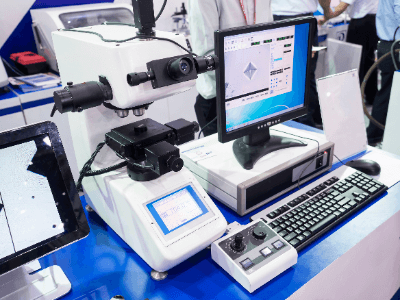What Is a Vickers Hardness Tester?
 A Vickers hardness tester is a hardness tester that evaluates hardness based on the indentation left by a diamond indenter. This tester measures the diagonals of the indentation after pressing the indenter into the test material with a specified load.
A Vickers hardness tester is a hardness tester that evaluates hardness based on the indentation left by a diamond indenter. This tester measures the diagonals of the indentation after pressing the indenter into the test material with a specified load.
Unlike the Brinell hardness tester, which uses a 10 mm iron ball indenter, the Vickers tester utilizes a diamond square with a 136° angle, allowing for precise measurement of the indentation on the test surface.
Uses of Vickers Hardness Testers
Vickers hardness testing is mainly used to evaluate the hardness of metallic materials, particularly suitable for small-range hardness assessments like heat-treated layers, the depth of these layers, and thin materials.
The Vickers test is effective for shallow depth evaluations because of its small test load. For example, assessing the hardness of carburized and quenched steel materials, where a large test load could press the indenter deeper than the hardened layer, making an accurate assessment difficult.
Principle of Vickers Hardness Testers
Vickers testers are versatile, allowing for arbitrary selection of test loads for accurate evaluation regardless of the test object’s thickness. Using a diamond square indenter, the Vickers test creates a small indentation, measured using a metal microscope.
By selecting the appropriate test load, the Vickers test can evaluate the hardness of thin specimens or surface treatments without the indentation penetrating the hardened layer. Specimen requirements for Vickers testing include surface flatness, parallelism, and roughness, typically prepared by polishing to a mirror-like finish.
Other Information About Vickers Hardness Testers
1. Difference Between Vickers and Rockwell Hardness Testers
Rockwell hardness testers, like Vickers, measure hardness by indenting the material but differ in indenter shape and measurement method. Vickers testers use a square pyramid diamond, while Rockwell testers use a spherical indenter. Vickers measures diagonal width, while Rockwell measures indentation depth.
Rockwell testers are quicker and more suitable for metallic materials at production sites but require different indenters and test conditions based on hardness. Vickers testers use the same indenter for different loads and provide consistent results regardless of load variation.
Vickers and Rockwell hardness values can be converted using standard tables.
2. Automatic Mechanism of Vickers Hardness Testers
Modern Vickers testers often include automatic mechanisms for measuring hardness at multiple points, particularly useful for carburized or welded parts with varying hardness. These systems can measure across a range of points and display hardness values as a gradation map, providing detailed information for development and troubleshooting.